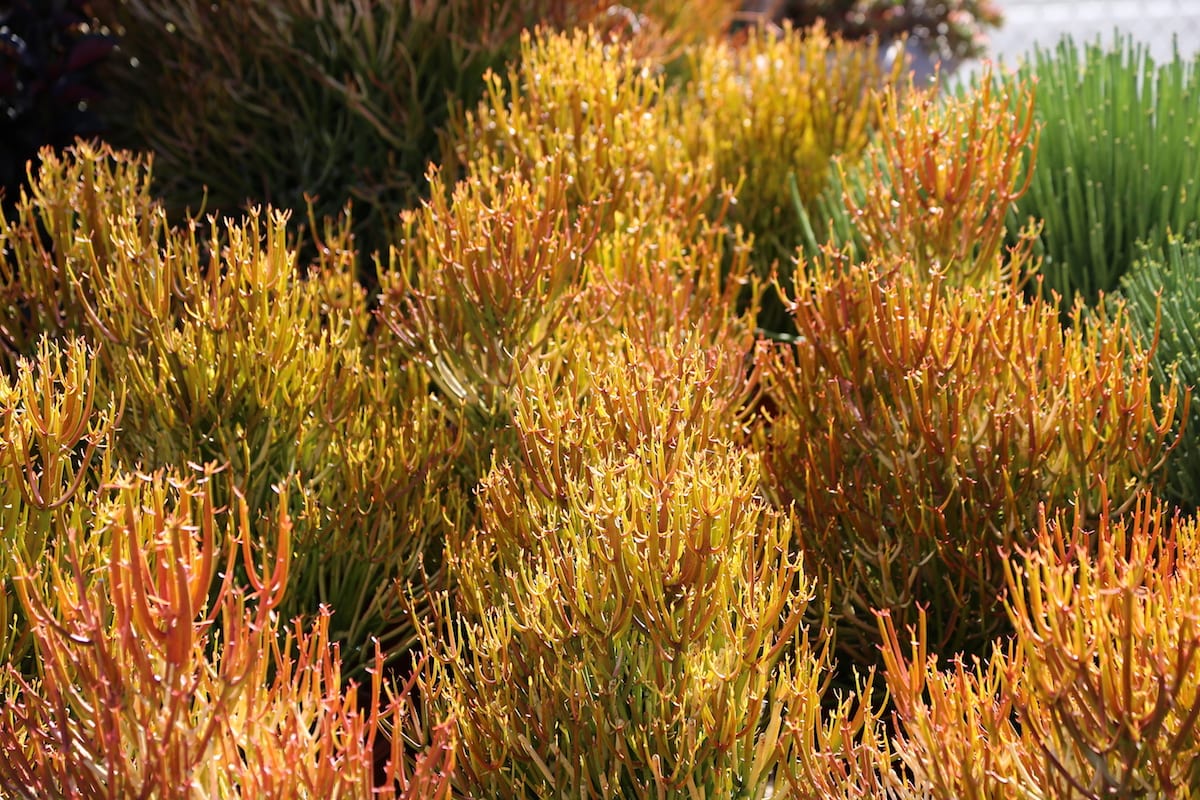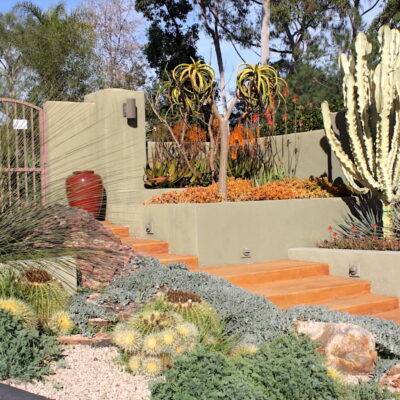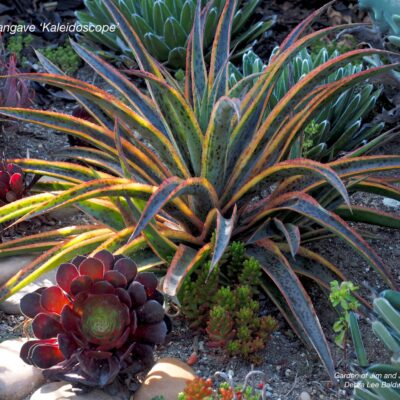
Succulent Landscaping Trends
As the author of two editions of Designing with Succulents ten years apart, I'm sort of obsessed with the evolution of succulent landscaping. Here's what designers and homeowners are discovering that works and (perhaps more importantly) what doesn't. These top six trends---call them preferences, if you like---may surprise you.

Yucca gloriosa 'Bright Star'. Design by Gardefacts, Santa Barbara.
1. About as many rocks as plants. Designers bring in boulders, create cobbled riverbeds, fill gaps with gravel, and pave pathways with granite sand.
See my video Why You Really Need Rocks and my article of the same name.

Pauma Valley, CA, garden by Deeter-Buckner design.
2. Statement succulents. The most memorable succulent gardens include specimen plants. These might be a tree aloe, a yucca, a cluster of silver swords (Cleistocactus strausii) or maybe an extraterrestrial-looking alluaudia. Designers set such look-at-me's atop planted mounds where they're backlit and prominent.

Euphorbia tirucalli 'Sticks on Fire'
3. Firesticks are falling out of favor. With its upright, pencil-thin and leafless orange stems, Euphorbia tirucalli 'Sticks on Fire' makes a dramatic backdrop succulent. But in frost-free climates, with regular water and good soil, it eventually gets huge and needs whacking back. Horrifically, people are ending up in hospital emergency rooms after accidentally getting the plant's milky, sticky sap in their eyes. Exercise extreme caution when trimming any succulent euphorbia, and never plant one where children, pets or passersby may come in contact with it.

Dainty succulents that look like flowers include blue echeverias. Make this succulent color wheel and more in Stunning Succulent Arrangements, my online, 7-session class.
4. Fewer fiddly plants. Echeverias and other rosette succulents tend to get lost in landscapes. You'll enjoy such pretties more in pots, flowerbeds and window boxes. "I'm shifting toward specimen gardens," says celebrity designer Laura Eubanks. "I still love doing succulent tapestries, but they're becoming more of a side dish."
Watch for an upcoming newsletter in which Laura Eubanks shares advice for aspiring succulent designers.

Want a big blue succulent? A better choice than Agave americana is Agave ovatifolia (hardy to 5 degrees F).
5. Smarter plant choices. As landscape professionals and DIYers discover the drawbacks of common, giveaway succulents like century plants (Agave americana), they're opting for alternatives with comparable visual appeal but far fewer problems.
View my videos: What You MUST Know about Century Plants and Six Great Agaves for Your Garden.

Phoenix Home & Garden beautifully showcases sleek, colorful Arizona gardens.
6. Desert-inspired designs. Arizona gardens are IT. No longer stereotyped as sparse, parched and prickly, they're now being lauded, photographed and admired for their dynamic silhouettes and bold simplicity. Such streamlined style, when modified according to climate, works anywhere that succulents and cacti thrive year-round. See Arizona elegance in Garden Design's interview with Phoenix landscape architect Steve Martino, and luscious desert gardens on Houzz and in Phoenix Home & Garden Magazine.
Other Helpful Resources
Succulent Landscapes
Succulent Landscapes Design ideas and must-dos for your yard’s transformation Want to transform your yard into a low-maintenance, low-water succulent garden? This page guides you to helpful info on this site and on my YouTube channel. Before you purchase plants or pick up a shovel, do obtain my book Designing with Succulents (2nd ed). It’s mainly about…
Patrick Anderson’s Exceptional Succulent Garden
I chose classical music for the video because Patrick, in addition to being a succulent expert, is an opera singer. In my YouTube video, “Patrick Anderson’s Succulent Garden,” I take you on a tour of the residential garden that launched my love of succulents. You’ll see it as it looks now, 25 years after I…
Jim Gardner’s Succulent Showcase
At Jim and Jan Gardner’s home near Los Angeles, hundreds of varieties of mature succulents and low-water companion plants pack a colorful, well-thought-out landscape. For over 40 years, the Gardners have lived in Rolling Hills Estates on the Palos Verdes peninsula, which juts from the coastline like a burl on an oak. It’s a highly…
Why You Really Need Rocks
Smart designers cover bare soil with rocks in succulent gardens that are as sophisticated and good-looking as they are practical.
Why Cactus is Popular
Long a pariah plant, cactus is gaining popularity. You could even say that in the gardening world, “cactus is the new black.” Here’s why spiny succulents are catching up with smooth ones, notably in art, home decor, clothing and gift items. A little perspective: The first edition of my book, Designing with Succulents (Timber Press,…






I really enjoy seeing the beautiful succulent gardens on your site. I notice that most are out West in Arizona, California and other areas. I live in South Georgia where it’s hot and humid. Can I grow these in my area too?
Hi Cheryl — Great question! It’s challenging for you to grow most of these plants in anything but a climate-controlled greenhouse. The problem is not the heat but humidity, dampness and summer rainfall. These are dry-climate plants adapted to living off the moisture in their leaves during periods of drought. They don’t know what to do with excess moisture. Pests and problems set in—like fungus, mildew and rot. There are, however, tropical succulents that you might try—such as hoya—but even those won’t be able to handle your cold winters. But I’m no expert in the horticulture of South Georgia. The best thing to do is to talk to members of your closest Cactus & Succulent Society chapter; observe what’s growing in neighbor’s gardens; and see what’s available in local nurseries.